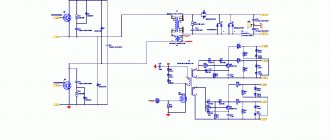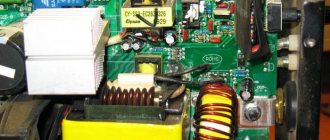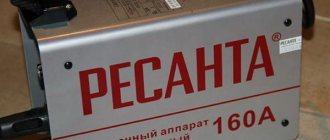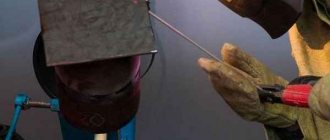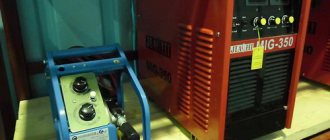Inverter-type welding equipment today is widely used in various industries, in public utilities, and in everyday life. The range of units is quite large and includes devices with different technical characteristics and functionality. To select the most optimal solution, it is necessary to analyze various parameters. In particular, you need to calculate how much power the welding machine consumes. This data can be easily calculated using a special formula.
Experienced welders are thoroughly familiar with the features of welding machines and understand the mechanism of operation of the equipment. If you are just starting to work with the inverter, be sure to read the instruction manual in detail. When calculating power consumption, the operating conditions of the equipment and the purpose of use should be taken into account.
Types of inverter devices
First of all, we recommend that you familiarize yourself with the types of inverter units. All models of this type are divided into three large groups. Each has its own characteristics. Let's take a closer look.
- Household or amateur. This includes models that are powered by a conventional single-phase 220V network. At maximum power, welding with such a unit can only take 20-30 minutes. Afterwards you need to give the device a chance to rest. This time is quite enough to perform one-time operations at home or in the garage. In addition, household inverters are inexpensive, compact in size and light in weight.
- Semi-professional. More powerful devices compared to units from the first category. They are capable of working for up to 8 hours without a break; they are purchased for use in auto repair shops and small enterprises.
- Professional. Welding equipment is designed for frequent use in difficult conditions. They are purchased for large enterprises and factories for the production of metal structures. They effectively weld parts from different metals, work for a long time without interruption, do not overheat, and are powered by a three-phase 380V network. But the models are also expensive.
If you buy equipment for use in the household, take into account one important nuance: the maximum load current should not be higher than 160A. Power circuit breakers and electrical fittings, which are installed in private houses and apartments, are not designed for a current higher than this value.
You cannot connect equipment with a current strength exceeding 160A to the household network. This can lead not only to the operation of the machines, but also to burnout of contacts or fire of electrical wiring. It's better not to let this happen. There are enough amateur-class models in the manufacturers' lines; choose a device from this category for home use, and buy professional ones only if you can connect the equipment to a 3-phase 380V network.
Customer reviews about the device "Resanta SAI - 220"
Below we suggest reading some customer reviews about the use of the Resanta SAI-220 welding device.
The device is simply a great thing and has a huge number of advantages compared to welding transformers. First of all, this is the compactness of the device. There is also a system against sticking of electrodes, thanks to which even a beginner can use it. It’s also nice to have an anti-overheating system that actually works. It doesn’t work in a transformer; the device simply turned off when it got too hot, and we had to wait for it to cool down. I am pleased with the affordable price and wide range of models, from household to professional. The only negative is that the wire for connecting to the network is very short.
Novel
I have been using this device for two years now, and there have been no breakdowns yet. The short, awkward wires were extended, but otherwise there were no problems. The arc holds perfectly when welding with three or four. The device weighs little, is easy to carry, and is also quite strong. I recommend to all.
Nova
For small jobs this device is the most practical.
During the construction of a building with several floors, I had to work with it for several hours without a break and in the heat, but the overload light did not even light up. At that moment, the device was already a year and a half old. It can withstand heavy loads, the device weighs less than 5 kilograms, and has a good level of protection. The case is made of metal, but the cables are short, I lengthened them, and the voltage did not weaken. Pulls heavy electrodes well. I do not recommend using it on heavy metal structures so that it does not burn out and nothing falls on it. But welding parts of a fence, car, heating pipes is the best!
Fedor
Inverter device design
Familiarization with the structure and mechanism of operation of the inverter will not only simplify operation, but will also help prevent breakdowns and malfunctions. So, first of all, the voltage of 220V with a frequency of 50 Hz turns from alternating to constant, and then again into alternating, but at high frequency. Then this voltage again becomes constant and is transferred to the working arc. The quality characteristics of the arc are controlled automatically. A special microprocessor built into the control unit is responsible for this. There is practically no arc sticking in inverters, and this is its significant advantage over transformer-type models.
When a short circuit occurs, which lasts no more than 0.5 seconds, the electronics generate powerful impulses. Due to this, the molten metal bridges are destroyed, which avoids sticking. If the short circuit lasts longer, the equipment shuts down completely. The electrode does not stick to the workpiece, and the machine circuit does not overheat. This is a fundamental difference between inverter-type devices and units that operate on transformers. Characteristic features of welding machines manufactured using inverter technology:
- increased productivity rates – up to 95%;
- no inductive losses during welding;
- resistance to voltage surges and short circuits;
- possibility of precise adjustment of operating parameters;
- electrodes of different sizes made from various raw materials can be used as consumables;
- safe operation, the device is equipped with highly effective protective mechanisms;
- instant ignition of an electric arc;
- compact dimensions;
- light weight.
Another important feature of inverter devices is electricity consumption. Regardless of power consumption, all energy is spent only on the work process. The efficiency of inverters is 85-95%. These are quite high figures.
Advantages of the device "Resanta SAI-220 PN"
The welding device "Resanta SAI-220 PN" has the following advantages:
- there is a current regulator on the welding arc;
- ensuring continuous long-term operation of the device due to the presence of intensive forced cooling of the device, which passes a large current;
- “anti-sticking” function, which automatically reduces the operating current in case of electrode sticking when igniting the arc. When the electrode comes off, the device restores the previously configured parameters;
- hot start function, improving the process of igniting the arc with a short pulse and an increased operating current parameter;
- the arc burns steadily, there are no unexpected extinctions, as when working with a conventional transformer.
And of course, an important factor is the positive reviews about the Resanta Sai-220 PN device from both amateurs and professional welders . Many reviews from professionals focus on the fact that inverter-type welding machines such as “Resanta” greatly facilitate welding work and make it of higher quality.
Studying the technical specifications
To choose a suitable inverter device, you should definitely study the technical characteristics of the models in question and read reviews about them. The power consumption of 220V equipment is calculated taking into account the following parameters:
- input voltage (minimum and maximum);
- current range;
- working arc voltage;
- Efficiency of the welding equipment model under consideration;
- PV or continuous on time;
- maximum power.
These parameters are specified in the instruction manual. Before buying welding equipment, familiarize yourself with what each of them means and how it affects power consumption.
The best models for semi-automatic welding (MIG/MAG)
This connection of elements is suitable for thin sheets of steel, non-ferrous and precious metals.
SAIPA-135
The model is equipped with a cooled transformer and a drum with wire feed for welding. Applicable for tasks of varying complexity.
Advantages:
Flaws:
Reviews
| Andrey Gusev | Timur Zolotin |
| “The device was purchased for body work. Carefully welds the seam at a minimum voltage. The wire spool can only hold 1 kg, so the tool is not suitable for large volumes of work.” | “The device is small and light, can withstand winter operation, and maintains a stable voltage, even when interacting with a generator.” |
SAIPA-190MF
Semi-automatic unit for domestic and industrial construction and repair work. It is reliable in operation, protected from overloads, and reports overheating using a special light sensor.
Advantages:
Flaws:
Reviews
| Vitaly Polyakov | Konstantin Khorev |
| “The device is compact with a wide range of functions. Perfectly performs tasks of welding car parts with electrodes and wire. The equipment is supplied promptly.” | “Welding is soft, both with carbon dioxide and with a gas mixture. Good penetration of the material up to 10 mm.” |
SAIPA-200
An inverter machine for fastening products made of ferrous and non-ferrous metals, ensuring an even and high-quality welding seam.
Advantages:
Flaws:
Reviews
| Stepan Fedotov | Yuri Gulyaev |
| “A powerful unit from a reliable brand, but it consumes a lot of electricity; under heavy loads, the home wiring may not be able to withstand it.” | “The device welds an even, neat seam and has good protection against overheating. You can adjust the power and feed of the equipment. He did an excellent job with the body parts of the car.” |
Characteristics of models for semi-automatic welding (MIG/MAG)
| Model | SAIPA-135 (MIG/MAG, MMA) | SAIPA-190MF (TIG, MIG/MAG, MMA) | SAIPA-200 (MIG/MAG, MMA) |
| Input voltage, V | 140-270 | 198-242 | 140-270 |
| Number of power phases | 1 | 1 | 1 |
| Welding current (MIG/MAG), A | 30-110 | 30-190 | 30-200 |
| Welding current (MMA), A | 10-110 | 10-190 | 15-200 |
| Welding current (TIG), A | — | 10-190 | — |
| Voltage at idle start, V | 65 | 80 | 80 |
| power, kWt | 6,60 | 5 | 5,50 |
| Operating voltage, V | 15,50-19,50 | 17,60-27,60 | 15,50-23 |
| Wire diameter, mm | 0,60-0,80 | 0,60-0,80 | 0,80-1 |
| Protection indicator | IP21S | IP21 | IP21S |
| Weight, kg | 9,82 | 11,26 | 9,3 |
| Price, r | 14030 | 19130 | 20170 |
Voltage
Let's start with the first characteristic - voltage range. This indicator is needed to determine whether the device can operate on the network to which you plan to connect it. If you buy a model for domestic use, choose from single-phase models; if for industrial use, choose from three-phase ones.
It is important that the equipment can operate at a lower voltage, because 220V is rare in household networks. In most cases, the voltage does not exceed 200V. Excellent power indicators are demonstrated by welding machines that function properly in a network with voltage from 150-170V to 220-250V.
How to prepare the Resanta SAI-220 device for operation
According to the instructions and reviews from professionals, the device must be connected from the low voltage operating circuit assembly:
- check the off position of the “network” switch;
- we connect welding cables with the required cross-section to the working power terminals;
- check the connection of the electrode holder;
- connect the second power work cable to the product you will be working with;
- connect the body of the Resana device to a stationary type grounding device; if there is none, then you need to prepare a pin with a length of 140 cm, which is driven into the ground;
- We connect the device to the network and supply it with standard voltage. Turn it off by turning the “power” switch;
- we set the required current mode using regulators for the operating direct current;
- We check the device for short circuits in the power working cables.
Operating modes depend on the diameter of the electrode used and the type of work.
Work without interruption
PV or on-duration is the time during which the welding machine is able to weld parts without interruption, determined as a percentage. Equipment operation is usually divided into cycles of 10 minutes each. But not all 10 minutes can be welded without interruption. If the duty cycle is 70%, then 7 out of 10 minutes can be worked continuously, then a stop should be made. As a rule, manufacturers designate different PVs for operation at different welding currents.
If you ignore the need to take regular breaks, the welding equipment itself will suffer. During prolonged operation without a break, the internal mechanisms overheat, the automatic relay is activated, and the unit turns off. Frequent operation in this mode negatively affects the condition and functioning of important components of the welding inverter.
Protective properties of the Resanta device
One of the features of the Resanta SAI-220 device is its safety of use not only for welding professionals, but also for beginners and amateurs. Thus, the conductive parts of the device are insulated .
And the device is connected to standard equipment via a flexible cable equipped with double insulation, which can withstand voltages of up to 3 thousand V for several minutes. From the inside, the device components are tightly fixed to insulators, which under no circumstances should be contaminated with metal dust or shavings. Also, liquids must not be allowed to get inside the device so that the phase does not short-circuit to ground. Objects up to a maximum thickness of 12 mm may be allowed to enter.
Calculation by formula
Now let's look at how to calculate the power factor. For this purpose, the formula is used: the duty cycle in minutes is divided by the sum of the operating time before and after stopping. We multiply the resulting number by 100. Let’s say the device welded metal regularly for 6 minutes without interruption. Then the protective mechanism was activated, it stopped the working process, the device “rested” for 4 minutes, after which it started working again. We calculate the coefficient using the formula:
6/(4+6) x 100 = 60%
The power factor for inverter devices of the amateur and semi-professional classes does not exceed 70%. As a rule, this figure is in the range of 60-70%. Data that may be required to calculate the power consumed by an inverter device is available in the technical documentation. The necessary information is posted on the manufacturer’s website, in the instruction manual, or directly on the page of the online store where you are going to buy the tool, in the Characteristics section.
Let's look at how to calculate power using the example of a unit with the following technical parameters:
- voltage MIN – 160V;
- voltage MAX – 220V;
- current strength – 160A;
- arc voltage – 23V;
- Efficiency – 0.89%;
- PV – 60%.
First, let's determine the maximum power. It is necessary to multiply the welding current by the working arc voltage. The resulting value is divided by the efficiency. Here's what happened:
160A x 23V / 0.89 = 4135 Watts
This is an indicator of the power required to power the unit directly during the welding process. To calculate the average value, you need to multiply the maximum power by the duty cycle and divide by 100%.
4135 x 60 / 100 = 2481 W.
The result is the nominal value of power consumption. Why is the rated power taken for calculations? The welding inverter will not operate at maximum current all the time. It stops welding at a lower current, so it is not advisable to buy a model with a power that is almost twice the required value.
By the way, you don’t have to calculate the power consumption yourself; the manufacturer has already done it for you. This characteristic is indicated in the technical documentation along with other indicators.
Selecting electrodes for a welding inverter
The power and current also determine which electrodes can be used with the unit. The range of consumables is very wide. Installing an unsuitable electrode leads not only to deterioration in welding quality, but also to breakdown of the inverter apparatus. We have compiled a table that will help you select electrodes.
| Thickness of metal workpiece (mm) | Current (A) | Electrode diameter (mm) |
| 1-4 | 20-90 | up to 2 |
| 5-7 | 90-130 | 3 |
| 8-12 | 140-180 | 4 |
| 12-16 | 180-220 | 5 |
| from 15 | from 220 | from 6 |
Consumable electrodes used for inverter welding must comply with the requirements of GOST 9467-75. Only such consumables can be considered safe to use; they ensure high quality of the welding process and leave behind neat, even seams. Electrodes are classified into those used for welding conventional (ANO) and critical (USSI) structures.
OZS-12 are popular electrodes that allow you to work at low currents. They can be used to work with low-carbon and carbon steels. ANO-36 is also often used; their surface is treated with a rutile cellulose coating. They light up easily and are recommended for those who do not yet have sufficient experience in using welding machines. Such electrodes are suitable for welding parts made of stainless and high-alloy steel. Consumables for welding aluminum sheets, cast iron and other metals are available for sale. The speed and efficiency of welding, as well as the quality of the seam, depend on the correct choice of electrode.
Safety rules and operating features of the device "Resanta SAI-220"
If you study the reviews of users of this device, you can conclude that it is very convenient and safe. However, its use is subject to compliance with the following safety regulations:
- if there is no grounding through the socket cord, you need to install portable grounding;
- the welding site must have good ventilation, since this process releases harmful and toxic substances;
- you need to wear a special suit to prevent burns;
- You need to wear a mask or welding shield on your face;
- Observe fire safety measures according to the instructions.
Despite the fact that reviews of the device are mostly positive, some contain some warnings related to the operating features of the Resanta device. For example, in damp weather the device may “pinch” with current. You also need to be extremely careful when working with the device and not deviate from the rules set out in the instructions.
